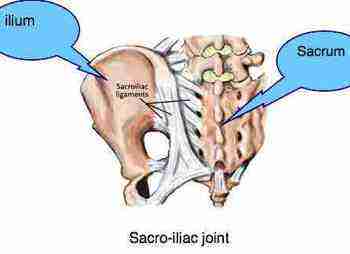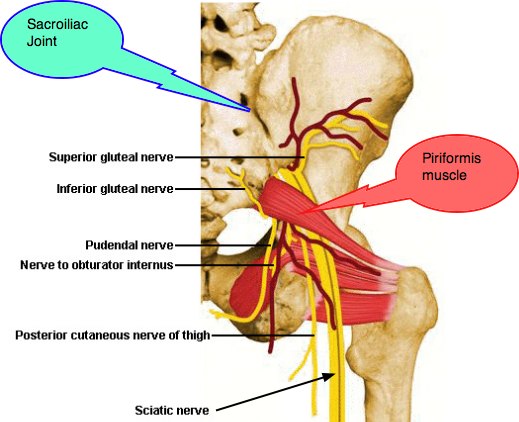Sacroiliac joint inflammation
Sacroiliac joint inflammation research proves that the prevalence of pain in the SIJ is at least as high as 13% and may make up nearly one third of lower back pain cases.
Researchers prove conclusively that the SIJ anatomy is a frequent, yet grossly underestimated cause of lower lumbar back pain including those cases with radiating pain to the lower leg.
It is well known that approximately 30 percent of patients with positive disc findings on MRI are completely symptom free. Yet, the authors point out, when a patient with low back pain has a postive scan, it is widely but erroneously assumed that the lumbar disc protrusion seen must be the underlying cause of the malady.
"CT and MR imaging techniques are not always helpful, because they have a poor degree of correlation with clinical signs.”

Read more about the sacroiliac joint anatomy.
METHODOLOGY
50 patients with suspected sacroiliac joint inflammation:
- low back pain
- positive disc findings on scan, but no hard neurological findings,
- positive pain provocation SI tests*,
- who had not responded well to
- anti inflammatory drugs,
- intramuscular injections and
- physical therapy
were submitted for sacroiliac joint infiltration with an anaesthetic plus a steroid.
RESULTS
- Prior to the infiltration the patients had a mean baseline Visual Analog Scale score of 7.8.
- 30 minutes after infiltration the average VAS score dropped to 1.3
- After 8 weeks, 46 of the 50 patients still had a VAS score of less than 3.
The author's conclusions are that sacroiliac joint dysfunction should be strongly considered in the differential diagnosis in patients with lower lumbar back pain, with or without leg pain, should they have positive pain provocation tests*, no hard neurological findings and even positive scans for lumbar disc protrusion.
Orthopaedic tests used
- Sacroiliac Joint compression test.
- Thigh thrust test (POsterior SHeer test: POSH test).
- Yeoman's test.
- (* to which I would add Patrick's Faber test)
“The current medical gold standard for the diagnosis of the SIJ syndrome is fluoroscopically guided infiltration of local anesthesia leading to at least an 80 precent reduction in Visual Analog Scale scores.”
However, imagine putting every patient with lower back pain through such a procedure; first, do no harm.
Innervation of the SIJ
The SIJ has a rich nociceptive innervation. Its
- anterior portion is innervated by the posterior rami of the L2–S2 roots, and its
- posterior aspect is innervated by the posterior rami of L4–S3.
The piriformis muscle is located close to the SIJ, originating at the anterior aspect of the sacrum and inserting into the greater trochanter of the femur. SIJ problems can cause piriformis spasm and provoke sciatic irritation, with pain radiating to the buttock, the posterior calf, and to the anterior and lateral calf and foot mimicking radiculopathy.

- Read more about Piriformis syndrome …
Of note concerning lower back and leg pain ...
- Low back pain is second only to common cold as a cause of primary care office visits in the USA.
- Approximately 90% of adults have experienced back pain at some point of time in their lives.
- Low back pain is responsible for direct care expenditures ranging from $5 billion to more than $20 billion annually (in the USA alone) and as much as $50 billion per year in indirect costs.
- Medical residents are not usually taught to consider sacroiliac joint inflammation and dysfunction as a cause for lower back and leg pain.
- More about Direct, Indirect and Intangible costs of lower back pain ...
Dr Fred W Illi
Swiss chiropractor Fred Illi came to the United States in 1940, 1942 and 1949, spending many months conducting dissection experiments on fresh cadavers. A young Dr Joseph Janse served as Dr Illi's assistant in these experiments.
In Dr Janse's own words:
"...neither in the chiropractic nor medical profession has anyone ever presented a more concise, thorough and exacting description of the structure, statics and dynamics of the spine and sacroiliac mechanism. It cannot and must be denied that Illi's works are monumental and classical, constituting by far the most brilliant single contribution in chiropractic research ..."
CHIROPRACTIC COLLEGE RESEARCH TOPICS
This medical research invites many thoughts about sacroiliac joint inflammation, not least of which is how it validates that early chiropractic pioneer Dr FW Illi, so scoffed by medicine at the time, who implicitly believed and proved that the sacroiliac joint is a freely movable joint.
Who is going to be the researcher to take up the cudgels and prove that we can better these medical results?
- What are the short and long term side effects of sacroiliac joint inflammation infiltration?
- Can the chiropractic adjustment provide better relief after 8 weeks, and 6 months than a VAS score of less than three?
- Can Chiropractic sacroiliac joint treatment do it better than physical therapy?
- What are the advantages of the lumbar roll -vs- Thompson drops, or a combination of adjustments and drops?
- Activator technique?
- The role of leg length inequality and a heel lift ... so much for the inquiring mind!
- Read more about COLLEGE RESEARCH TOPICS …
- SACROILIAC JOINT TREATMENT ...
Leg pain during pregnancy
Leg pain during pregnancy is a not infrequent complaint in the
chiropractic clinic. Usually from the sacroiliac joints, or the
insertion of the deep pelvic muscles in the groin, occasionally a
sciatica.
Sacroiliac joint inflammation
Researchers prove conclusively that the SIJ is a frequent yet underestimated cause of lower back pain.
- Home >
- Sacroiliac Joint >
- Sacroiliac joint inflammation
Did you find this page useful? Then perhaps forward it to a suffering friend. Better still, Tweet or Face Book it.
